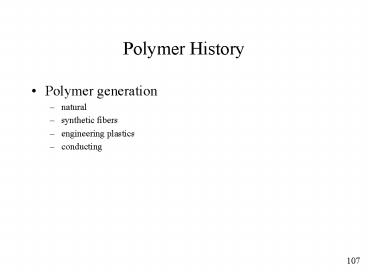22 November Lecture - PowerPoint PPT Presentation
1 / 45
Title:
22 November Lecture
Description:
Conjugated polymers with alternating single and double ... rechargeable batteries. chemical sensors. photo-voltaics (solar cells) light emitting diodes (LED) ... – PowerPoint PPT presentation
Number of Views:38
Avg rating:3.0/5.0
Title: 22 November Lecture
1
Polymer History
- Polymer generation
- natural
- synthetic fibers
- engineering plastics
- conducting
107
2
Requirement for Polymer to Become Electrically
Conducting
- Conjugated polymers with alternating single and
double bonds or conjugated segments coupled with
atoms providing p-orbitals for continuous orbital
overlap
108
3
Electrical Properties
- Polymers traditionally been used as insulators
- Conductivity (s) is expressed in units of siemens
(S) per cm (siemen is a reciprocal ohm) - s lt 10-8 S/cm insulator s 1/p
(resistivity) - 10-7-10-1 S/cm semiconductor
- gt 102 S/cm conductor
109
4
Comparison of Electrical Conductivities
110
5
Opportunities for Conducting Polymers
- Properties of electrical, electrochemical and
chemical - corrosion prevention of metals
- anti-static floor tiles
- rechargeable batteries
- chemical sensors
- photo-voltaics (solar cells)
- light emitting diodes (LED)
- photochromic devices
- lasers
111
6
Polyacetylene
- H. Shirakawa
- Ziegler Natta catalysis
- p-doping
112
7
Doping
- Charge injection (transfer) into conjugated
systems - chemicalp-type doping (oxidation)
(p-polymer)n-type doping (reduction)
(p-polymer)- - electrochemicalelectrodes supply redox charge to
the conducting polymer doping level determined
by voltage
113
8
Doping
- photochemical
114
9
Doping
- Semiconducting polymer interface e- and holes
can be injected from metallic contractspolymer
is oxidized or reduced however, nocounterion
115
10
Application Depends upon Property
116
11
Example of Conducting Polymers
117
12
Example of Conducting Polymers
118
13
Light-Emitting Application of Conjugated Polymers
- Single-layer electroluminescent polymer LED device
119
14
Light-Emitting Application of Conjugated Polymers
- Balancing e- and hole injection from electrodes
in order to balance charge transport - bilayers(1) electron-transport layer (ETL) with
a combined hole-transport (HTL) and emission
layer (2) hole-transport layer and a combined
electron transport and emission layer - trilayer(1) HTL, emission layer, ETL
120
15
Light-Emitting Application of Conjugated Polymer
- Going to bilayer and trilayer usually increases
device efficiency lowers threshold and operating
voltage because balancing charge injection and
transport with recombination of the e- and hole
taking place at the interface between layers and
not at the interface between the organic material
and one of the electrodes.
121
16
Polymer Structure and Color Emitted
- Controlling band gap between LUMO and HOMO
122
17
Polymerization
- Chain reaction
- free radical
- cationic
- anionic
- group transfer
- Ziegler Natta
- Step reaction
- linear polymers can be synthesized from
difunctional monomers - AB AB ABAB
- or
- AA BB AABB
123
18
Control of Polymer Structure
- Polymer synthesis
- Suzuki cross coupling
- (2) Heck reaction
- McMurry reaction
- Knoevenagle reaction
- Wittig reagents
- (6) Grignard coupling
- (7) Yamamoto coupling by Ni(O)
- (8) Metathesis (ROMP)
- (9) Other
124
19
Heck Chemistry
- Heck reaction
125
20
Heck Chemistry
- Example
126
21
Coupling by Suzuki Reaction
- Cross coupling of organic boronic acids or esters
with organic/halides - Mechanism
127
22
Coupling by Suzuki Reaction
- Example
128
23
Coupling by Suzuki Reaction
carried out in 2-phases - organic solution/Pd
complex/monomer/polymer - water and Na2CO3 to
remove acidic byproducts
129
24
Coupling by Suzuki Reaction
130
25
Coupling by Suzuki Reaction
131
26
McMurry Chemistry
- McMurry reaction
- Mechanism
132
27
McMurry Chemistry
- Example
133
28
Knoevenagle Chemistry
- Knoevenagle reaction
- in general
134
29
Knoevenagle Chemistry
- Example
135
30
Wittig
- Wittig reagentsPhosphorus ylids react with
aldehydes and ketonesto form an alkene product
through a betaine intermediate which collapsed to
an oxaphosphetane. Driving force is formation of
f3PO.
136
31
Wittig
- Variations called Hornes-Wadsworth-Emmons. Use
of phosphonate ester derivatives
137
32
Wittig
- Examples
138
33
Grignard Coupling
- Diorgano nickel (11) complexes, NiR2Ln undergo
reductive coupling reactions to give R-R - Mechanism
139
34
Grignard Coupling
- Example
140
35
Grignard Coupling
- Intermediates
141
36
Polyphenylene
- Problems with making PPP
- poor solubility
- if put groups to help solubility of polymer then
decreases reactivity of dibromoarene
142
37
Coupling by Zero-Valent Nickel
- Yamamoto reactionDrawback with Grignard reagents
is that these react with ketone and ester groups.
Therefore, Grignard coupling cannot be employed
with certain groups. - Mechanism
143
38
Coupling by Zero-Valent Nickel
- Example
144
39
Coupling by Zero-Valent Nickel
- Intermediates
145
40
Coupling by Zero-Valent Nickel
- Intermediate Why not?
146
41
Coupling by Zero-Valent Nickel
- Intermediate Why not? (maybe steric)
147
42
Coupling by Zero-Valent Nickel
L2 2,2-bipyridine
148
43
Metathesis
- ROMP (ring-opening metathesis polymerizationc
arbon-carbon double bonds of the monomer are
retained in the polymer
149
44
Metathesis
- Metathesis
150
45
Other
- Soluble Polymer Precursor Synthesis
151































